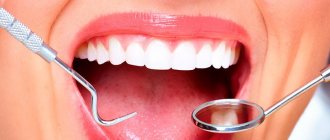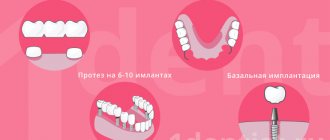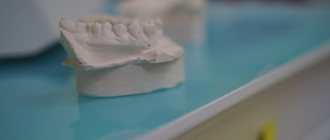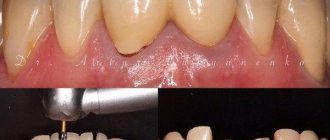In what cases is it removed?
- Rejection . Usually occurs in the first three to six months after implantation. Less often - after a year of use. The reason may be a violation of the surgical protocol during the operation, improper care of the system by the patient, or illness.
- Peri-implantitis and mucositis. The first is an inflammatory process of soft tissues, accompanied by loss of jawbone volume, the second - without loss. Occurs due to wound infection.
- Overloaded titanium structure usually occurs due to improper installation.
- Incorrect placement is rare. Only an inexperienced doctor can make a mistake when installing a system, so when choosing a specialist you need to ask how long he has been practicing and look for reviews about his work.
- Implant defects - this situation is excluded from well-known brands. Each element undergoes multi-stage testing, during which low-quality products are eliminated. Cheap analogues do not undergo as many studies as expensive models, and if a defect is discovered, not every manufacturer will agree to a replacement.
- End of service life - requires removal of the implant. However, proper care can increase the service life.
- The implant is removed if the inflammatory process does not go away within two weeks with active treatment.
If there is a disease that is not associated with tissue inflammation, and the titanium rod has already taken root, then its removal is undesirable. In this case, measures must be taken to treat the existing pathology.
Peri-implantitis
Peri-implantitis is one of the most common reasons that an implant does not take root. When this complication develops, the soft tissue around the implanted implant becomes inflamed. Gradually, the inflammatory process is transferred to the bone and begins to destroy it. The titanium rod begins to loosen, and the periodontal pocket deepens. Then the purulent process develops. In most cases, peri-implantitis develops immediately after surgery, sometimes inflammation occurs several weeks or months later.
Symptoms of peri-implantitis are:
- Redness of the gums around the implant, severe swelling.
- Pain that intensifies when you press on the gums.
- Bleeding at the surgical site.
- The appearance of fistulas on the gums, from which purulent contents are released.
- Loosening of the implant.
You should consult a doctor at the first symptoms of peri-implantitis. At an early stage of development, inflammation can be treated and the implant can be preserved. Delaying a visit to the implantologist in most cases leads to the fact that the implant will have to be removed.
Dentistry for those who love to smile
+7
Make an appointment
Causes and symptoms of implant rejection
The main indication for titanium root removal is rejection. There may be several reasons for this:
- violation of the integrity of the rod due to mechanical trauma or overload;
- development of peri-implantitis, mucositis, osteoporosis in forms that cannot be treated;
- incorrect installation;
- allergic reaction to the structure;
- serious disruption of the immune system;
- significant increase in blood sugar;
- exacerbation of chronic diseases;
- failure by the patient to follow the doctor’s recommendations in the postoperative period;
- smoking, drug addiction, alcoholism (included in the list of contraindications for implantation);
- neglect of the rules of oral hygiene (dangerous due to the development of inflammatory processes, activation of pathogenic microbes and infection of the jaw structures).
The reason for removing a dental implant may also be a specialist error :
- preliminary sanitation of the oral cavity was carried out poorly;
- no pathologies from the list of contraindications to the procedure were identified;
- the chosen technique did not correspond to the state of the bone structure;
- incorrect selection of implant;
- poor quality titanium construction;
- a refill with an expired expiration date was supplied;
- violation of sterility conditions during surgery, surgical protocol;
- incorrect choice of location for implantation of the system;
- using a faulty surgical instrument.
- Complete restoration of the dentition in just 4 days!
more detailsRoott Pterygoid Implants Sinus lift is no longer needed!
more details
Once and for life! Express implantation in 4 days with a permanent ReSmile prosthesis
more details
All-on-4, All-on-6, ReSmile, Zygomatic implantation We use all modern methods of dentition restoration
more details
Implant rejection is accompanied by a number of clinical manifestations that should not be ignored by the patient. Suspicious symptoms should be reported to your doctor immediately.
You should be wary:
- severe pain in the area of the implanted system;
- redness, blueness, swelling of the gums;
- compactions, bumps with purulent contents on the mucous membrane;
- bleeding;
- prolonged bleeding.
Medical errors
Medical errors are not common, but they cannot be completely excluded. The most common mistakes that can lead to the need to remove the implant are:
- Implantation of an implant in case of insufficient volume and height of bone tissue without prior osteoplasty.
- The operation was performed in the presence of contraindications, resulting in physiological rejection of the artificial root.
- Infection during surgery due to improper antiseptic treatment.
- Incorrect selection of prosthesis. As a result, the implant is subjected to too much stress that it cannot handle. Sometimes an unsuitable denture leads to improper distribution of the chewing load, which can result in loosening of the implant.
- An error during prosthetics when the prosthesis is installed on an implant that has not completely taken root.
- Low quality of the implantation system.
- Incorrect placement and size of implants.
In some cases, the artificial root can be saved if the patient contacts the clinic at the first signs of implant failure. But sometimes it is necessary to remove the implant.
Dental implant removal process
Removing an implant is a surgical operation performed under the influence of an anesthetic. It consists of several stages:
- Removing the tooth crown.
- Unscrewing the abutment.
- Removing the rod from the jaw.
- Antibacterial treatment.
- Establishing the causes of rejection to select the correct treatment.
Next, the recovery stage begins, based on the patient’s compliance with the specialist’s prescriptions and proper oral care.
Many people faced with this unpleasant situation are concerned with the question: “How long does it take for the gums to heal after removal of the implant?” This usually takes at least two months . Then re-implantation is possible.
Prices for services
Implantation Straumann Roxolid SLActive RUB 52,000.
Implantation Straumann Roxolid 44,000 rub. Consultation with a specialist 500 rub. Extended consultation of several specialists with the development of a comprehensive treatment plan RUB 1,500. Closed sinus lift 18,000 rub. Open Sinus – lifting 47,000 rub. Guided bone regeneration (restoration of the height and width of the alveolar ridge) (for a segment of up to 4 teeth) RUB 40,000. Bone grafting using an autologous bone block RUB 56,000. Implantation Nobel (Replace CC/Parallel CC) RUR 44,000. Implantation Osstem (Korea) 29,000 rub. Implantation whiteSky (Bredent) 85,000 rub. Expert doctor:
Amiridi Dmitry Nikolaevich
Dental surgeon, implantologist, chief physician
How to avoid implant removal
Preventing implant removal is not difficult. To do this, you need to follow the doctor’s recommendations and follow simple rules for caring for the oral cavity after surgery:
- do not eat solid food;
- exclude spicy, sour, hot, cold foods, strong coffee from the diet;
- stop smoking (tobacco smoke interferes with the implantation of the structure);
- do not subject the artificial root to increased loads;
- avoid situations that are traumatic for the jaw;
- do not visit the sauna, bathhouse;
- brush your teeth twice a day (in the morning - after breakfast, in the evening - before bed);
- use additional dental care products: irrigator, floss;
- Visit a specialist regularly and undergo examination.
General description of the procedure
- Anesthesia is performed.
- The crown is removed using forceps;
- An incision is made in the gum to remove the rod. If the structures are installed on the upper and lower jaws, a double-jaw osteotomy is performed. After access to the structure, it is removed using an elevator.
- The pin is removed.
For mobile artificial roots that have little residual contact with the bone, the same tools are used as for removing a regular tooth.
Also used for extraction are a bur and a trephine - this is a bur with a very small diameter, which allows minimal impact on the tissue. It rotates at low speeds and has additional cooling. When using a drill, patients may be nervous, so some clinics use piezoelectric devices and lasers for osteotomy of the lower or upper jaw. Piezoelectric devices destroy the implant-bone connection using ultrasonic waves. The method is mainly used on broken and misplaced implants. Compared to trephine surgery, the bone heals faster.
Clinical cases
Let us give examples from life regarding the unsuccessful completion of osseointegration, which resulted in the removal of the implant.
- After chemotherapy, a man had a titanium structure installed on the area of his jaw that had a malignant formation. The patient did not inform the doctor about the presence of a serious pathology, and the doctor did not notice bone changes in the operated area. Naturally, engraftment did not take place due to a decrease in the regenerative function of the bone. After the removal of the rod, six months passed before reimplantation became possible. During this time, the implantologist and oncologist actively took measures to solve the problem.
- The patient was treated by an orthodontist. She was fitted with braces and offered to have one tooth implanted. Since there was not enough space for it, bone augmentation was performed. After integration of the artificial root, it was rejected due to compression by neighboring teeth, as a result of which it was removed.
Doctors of this specialty
Amiridi Dmitry Nikolaevich
Dental surgeon, implantologist, chief physician
Make an appointment
Karyatov Vitaly Vladimirovich
Dental surgeon, implantologist
Make an appointment
Prevention of negative consequences
The specialist must:
- prepare the oral cavity for surgery;
- diagnose diseases included in the list of contraindications;
- perform plastic surgery of the jawbone, if required;
- follow the surgical protocol for the procedure;
- ensure complete sterility;
- issue recommendations for the rehabilitation period.
The patient must:
- inform the doctor about existing serious illnesses;
- undergo the necessary examination;
- carry out assignments;
- ensure quality oral hygiene.
What the patient should know
Every person who is going to undergo a dental implant procedure must have the following information:
- implantation is a commercial service and is not included in the list of “Compulsory health insurance”;
- a denture that is broken for no reason by the patient can be replaced free of charge with a new one only in the clinic where it was placed;
- the cost of treating complications is much higher than the cost of implantation , so it is necessary to strictly adhere to the specialist’s prescriptions.
An important point is the selection of the clinic. Well-established dental centers provide a long-term guarantee on their work and are responsible for its quality.
Reviews
I have been visiting this dentistry very often lately. I had implants and crowns installed by dental surgeon Dmitry Nikolaevich Amiridi. I especially liked his professionalism! The doctor is punctual, quickly provides services, provides detailed consultations and gives practical advice. All essentially, without excess water. He is attentive and treats his patients well. Overall, the clinic is clean and tidy, making it comfortable to be in. The service at the reception is also excellent!
Tatiana
Service: Implantation
I thank Dmitry Nikolaevich Amiridi and his team of professionals! Everything in your clinic is at the highest level!
Stanislav
Service: Implantation
Good afternoon. I have been a client of the Axioma Dental dental clinic for more than three years. I would like to note the professionalism of the doctors, the comfortable atmosphere (the clinic has been newly renovated), and the convenient recording and reminder system. All necessary information about treatment and further prevention is always provided. Thank you
Novel
Service: Implantation
What determines the service life of a dental implant?
The service life of the implant assumes the warranty specified by the manufacturer on the packaging. Companies that produce premium dental structures, for example, Nobel Biocare, Astra Tech, XIVE Friadent, Straumann, give them a lifetime guarantee . They will not have to be changed unless unforeseen circumstances arise.
Other companies set a period of 20-25 years . After this time, the worn-out implant, if defective, must be removed. Although, with proper care, even such options last longer than the manufacturer indicated.
The service life of titanium roots is affected by:
- qualified work of an implantologist;
- professionalism of the orthopedist in the manufacture of the prosthesis;
- high quality construction;
- proper oral hygiene;
- absence of serious diseases.
The presence of these conditions favors the long-term operation of installed dental systems.











